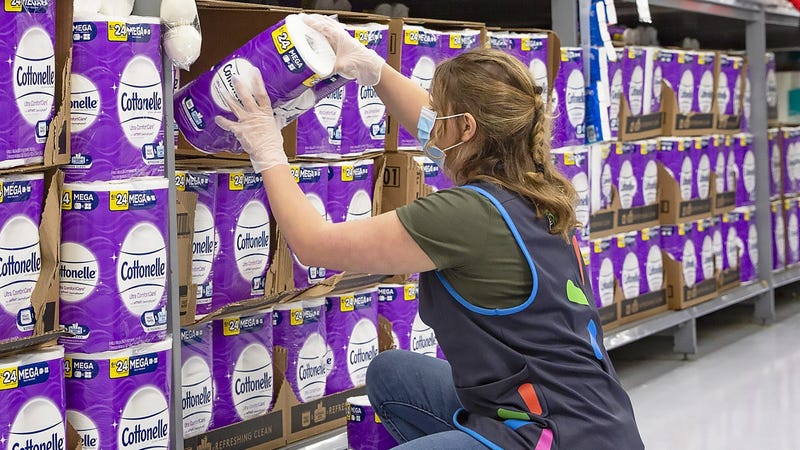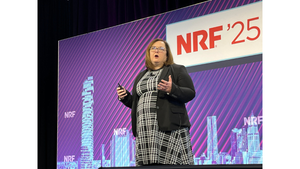Retailers adapt to meet demand for household suppliesRetailers adapt to meet demand for household supplies
Cleaning supplies and paper goods were the first targets of panic buying, but supply chain challenges are easing
May 19, 2020

Consumers stripped supermarket operators’ shelves bare of many paper products and household cleaning supplies during the first weeks of the COVID-19 pandemic, and retailers and suppliers have been scrambling to keep up with demand ever since.
For the eight-week span through April 25, year-over-year sales of all household care items rose 45.6% across U.S. retail channels, according to Nielsen. That included gains of 245.2% for aerosol disinfectants; 229.2% for hand sanitizer; and 145.9% for multipurpose cleaner wet wipes.
In addition, sales of bath tissue shot up 78% for that eight-week period, and sales of paper towels rose 64.7%.
Driving demand for these items was the combination of consumers’ increased focus on health, as they cleaned and disinfected everything around them more frequently, and a desire to hoard products they feared might be harder to obtain as the virus raced across the country.
Consumers stripped supermarket operators’ shelves bare of many paper products and household cleaning supplies during the first weeks of the COVID-19 pandemic.
Samrat Sharma, U.S. CPG lead at consulting firm PwC, said the pandemic will only accelerate the shift of these products to online channels.
‘’These categories are very online-friendly,” he said, citing data showing the pace of online sales growth doubling in 2020. “They were already moving online, and we expect that to continue. These habits are going to stick, post-COVID.”
Retailers, meanwhile, have been innovating to keep their physical stores in stock. They have expanded their product sourcing to include new manufacturers, instituted policies to limit purchases and have been taking some logistical shortcuts, such as direct delivery from manufacturers to stores, in order to replenish their shelves as quickly as possible.
Regional variations in demand have also led some retailers to transfer inventories to needed areas, and to allow individual store managers to implement buying limits to bolster their in-stock positioning.
Sales double at SpartanNash
At Grand Rapids, Mich.-based SpartanNash, sales of household cleaning and paper products have more than doubled in the last 12 weeks, said Ben Postma, director of center store merchandising in an interview with SN in early May. SpartanNash operates retail stores in nine states and distributes to independent retailers in all 50 states.
“Consumers have been reacting to the uncertainty of the virus, as well as concerns around supply availability, which led to buying in larger volumes than they normally do,” he said.
The company has seen its market share of sales in these categories grow during the pandemic, Postma said, which he attributed to the strong appeal of local grocery stores. The relatively small footprints of the company’s own banners and those of its independent customers have provided a convenient shopping solution for customers, he said.
Although demand has varied by geography, Postma said sales of both food and other household products spiked in the first few weeks of the pandemic following major announcements, such as school closings, bars and restaurants transitioning to off-premises-only sales and statewide stay-at-home orders.
SpartanNash has been working closely with its suppliers on a daily basis to understand the demand and maximize the supply the company could receive, Postma said.
“It was critical to align the supplier capabilities and increased consumer demand with the amount of inventory we needed to order,” he said. “As we worked through this process, we wanted to ensure all of our customers were getting their fair share of available supply.”
The company established case limits for its stores in certain areas, and also reached out to new suppliers to provide items in areas where inventories were stretched thin, Postma said.

Walmart has taken steps to replenish cleaning and paper products quickly, including diverting products to areas of the country where they are needed most and routing deliveries directly to stores.
Meanwhile, Bentonville, Ark.-based Walmart — the nation’s largest retailer — said paper products, cleaning supplies and other items have remained in high demand throughout the crisis.
“We are working to replenish those items quickly, including diverting products to areas of the country where they are needed most and routing deliveries directly to stores,” said Delia Garcia, senior director of communications at Walmart.
She said the company has also authorized its individual store managers to manage their inventory, including giving them the discretion to limit sales quantities on items that are in unusually high demand.
Lingering effects
Postma of SpartanNash said he expects supermarket sales of both food and other household supplies to remain strong after the pandemic.
“Disinfecting products will continue to be a focus due to consumer desire to kill germs and disinfect, as opposed to just clean,” he said. “Customers in all age brackets are adopting more rigorous cleaning habits, and the lingering effects of the fear of illnesses will remain in consumers’ minds.”
In addition, even as stay-at-home orders are lifted around the country, consumers are likely to continue their increased levels of in-store grocery shopping as they may remain fearful of dining out. Many consumers will also be feeling the financial pressures of the weakened economy, which may also constrain their ability to dine out.
“The slow transition back to ‘normal’ could lead to fewer trips to the store, but larger basket sizes per trip,” said Postma. “Many consumers have also adapted to ecommerce and curbside pickup to limit exposure to the virus. The appeal of convenience and safety means many will continue purchasing groceries this way.”
Suppliers respond to production challenges
Suppliers of household cleaning products have faced multiple hurdles in their efforts to keep stores stocked, said PwC's Sharma, although he said overall the supply chain was resilient and has been quickly catching up to demand.
Among the challenges that have delayed production for some suppliers, for example, has been the difficulty in obtaining some key ingredients. For all CPG goods, suppliers have also coped with challenges around absenteeism in their production facilities, as workers either became ill or were fearful of catching the virus at the workplace.
“You will see some of these fluctuations happen,” said Sharma. “Outside of that, manufacturers have done well to shore up their supply chains.”
SpartanNash's Postma said most suppliers depleted their surplus “safety stock” of inventory during the initial wave of increased demand in March. Most of the company’s cleaning and paper suppliers began running production at their facilities 24/7, and some added new co-packers or rented production locations to increase their supply, he said.
According to retailer and wholesaler SpartanNash, most suppliers depleted their surplus “safety stock” of cleaning product inventory during the initial wave of increased demand in March.
“Most of them have now moved to a simplified portfolio of items, focused on their top sellers covering each segment of the business,” Postma said, noting that doing so decreases the downtime that normally occurs as manufacturers switch their production among different products.
Walmart's Garcia said some suppliers have come up with innovative ways to meet demand for high-volume items. One supplier, for example, has taken a production line that had been dedicated to manufacturing glue and has converted it to produce hand sanitizer instead.
Some suppliers have also put weekly allocations into place to ensure all of their distribution partners receive a fair share of the overall inventory, said Postma of SpartanNash. He noted that cleaning-product manufacturers also supply the healthcare industry, “and that rightfully has been a priority over retailers.”
“We all have a common goal of getting as much of the COVID-19 prevention products into the end consumer’s hands as quickly and efficiently as possible to mitigate the health risk and take care of their needs,” Postma said.
For our most up-to-date coverage, visit the coronavirus homepage.
About the Author
You May Also Like






.webp?width=300&auto=webp&quality=80&disable=upscale)